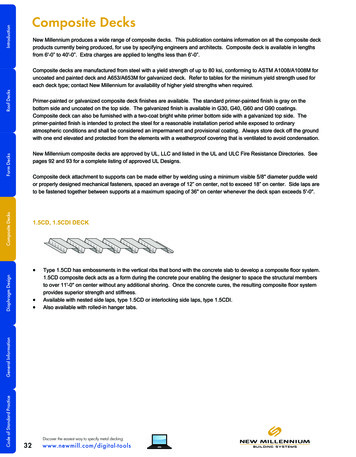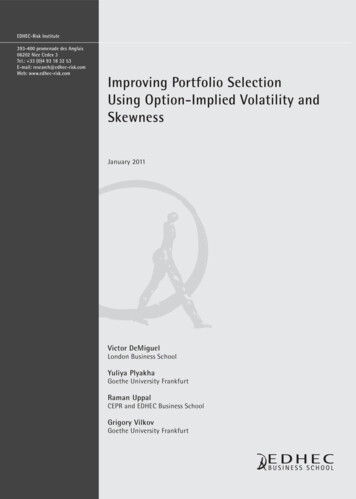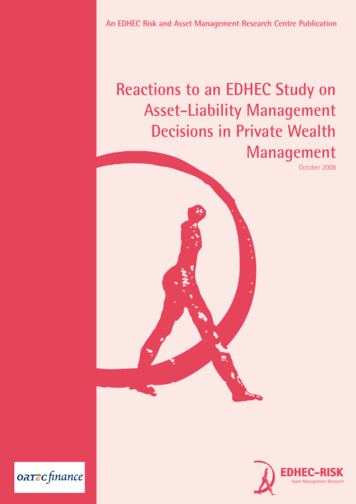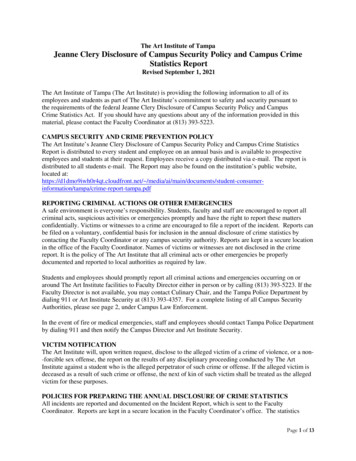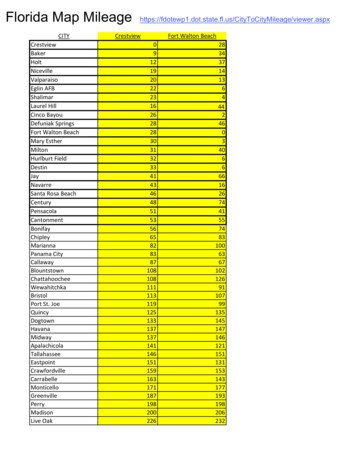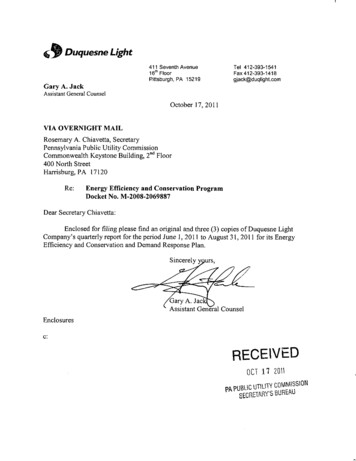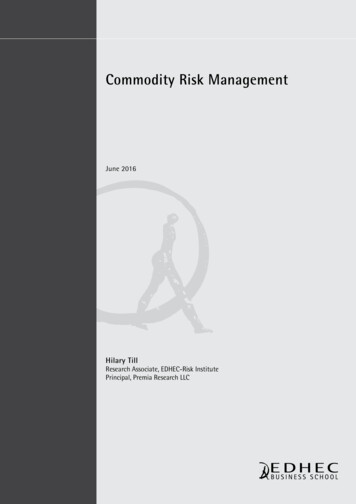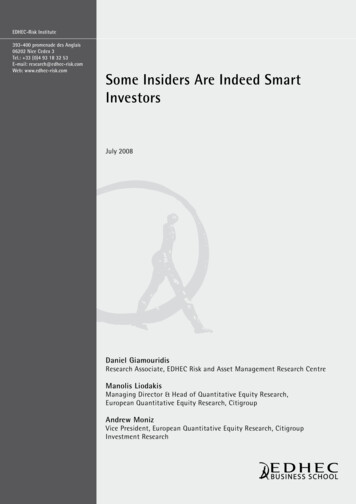
Transcription
EDHEC-Risk Institute393-400 promenade des Anglais06202 Nice Cedex 3Tel.: 33 (0)4 93 18 32 53E-mail: research@edhec-risk.comWeb: www.edhec-risk.comSome Insiders Are Indeed SmartInvestorsJuly 2008Daniel GiamouridisResearch Associate, EDHEC Risk and Asset Management Research CentreManolis LiodakisManaging Director & Head of Quantitative Equity Research,European Quantitative Equity Research, CitigroupAndrew MonizVice President, European Quantitative Equity Research, CitigroupInvestment Research
AbstractNot all insiders are the same; some are more effective than others in processing the informationthey have access to, and invest their own wealth accordingly. We used a database withtransactions from the U.K. market to identify insiders with superior market timing abilities. Forthe period 1994 to 2006 we showed that informative insider trades can be identified ex antethrough certain characteristics of the transactions and the firm itself. Moreover, we showed howoutsiders could benefit from this information. We created a long-only portfolio strategy thatgenerated an economically and statistically significant return. In addition, we showed that theinsider transactions' signal can be used to construct a satellite strategy that enhances the returnsof a typical quant investment portfolio.We thank Adam Strudwick for excellent research assistantship and Robert Korajczyk for providingmany useful comments. Any remaining errors are our own.EDHEC is one of the top five business schools in France. Its reputation is built on the high qualityof its faculty and the privileged relationship with professionals that the school has cultivatedsince its establishment in 1906. EDHEC Business School has decided to draw on its extensiveknowledge of the professional environment and has therefore focused its research on themes thatsatisfy the needs of professionals.2EDHEC pursues an active research policy in the field of finance. The EDHEC Risk and AssetManagement Research Centre carries out numerous research programmes in the areas of assetallocation and risk management in both the traditional and alternative investment universes.Copyright 2009 EDHEC
1. IntroductionThe trading activity of insiders, i.e., corporate officers, directors, and large stockholders, hasattracted the interest of both academics and practitioners for over forty years. The core themefor many researchers has been to investigate the ability of insiders to time the market. Previousempirical work in this area based on U.S. data unanimously shows that insiders are indeed betterinformed and earn positive abnormal returns (see, e.g., Jaffe, 1974, Seyhun, 1986, Lin and Howe,1990, Lakonishok and Lee, 2001). Evidence from other markets provides similar conclusions (see,e.g., Baesel and Stein, 1979, for Canada, King and Roell, 1988, Pope et al. 1990, Gregory et al.1997, Fidrmuc et al. 2006, for the U.K, Betzer and Theissen, 2007 for Germany, Del Brio et al.,2002, for Spain). A counterexample is a study by Eckbo and Smith (1998), who show that insidersof firms listed in the Oslo Stock Exchange do not earn abnormal profits. Also Datta and IskandarDatta (1996) report significant price reactions for convertible and straight bonds in response toinsider transactions.A number of studies have investigated the informational role of insider trading also in a broaderfashion. Based on their transactions around corporate actions/events, this strand of literatureshows that mangers are indeed better informed than outside investors about their firms' prospects.For example, John and Lang (1991) show that insider trading is associated with the share pricereaction after a dividend announcement. Allen and Ramanan (1995) find that insider buyingconfirms the favourable information captured by positive unexpected earnings. Ikenberry et al.(1995) prove that corporate share repurchases predict high future returns and Lee (1997) showsthat top executives' trading is associated with the long-run stock returns of seasoned equityissuing firms.The overall evidence thus suggests that insiders possess superior information and that theirtrading activity conveys important signals to the market. This paper presents the results ofresearch investigating how outside investors can benefit from this information. In particular, wedevelop systematic rules that identify insider transactions with the highest possible informationcontent. And we show how to turn these rules into portfolio strategies that have economicallyand statistically significant performance. Our study differs from previous research in severalimportant aspects. First, we develop a model/process that classifies insider transactions into more/less informative. This model incorporates well known hypotheses in the form of factors that toour knowledge are used for the first time in this literature. These factors are used to detectinformative insider transactions. Second, we carry out our investigation with the most extensivedatabase available for the U.K. market. It overlaps only for a short period with the dataset used inFidrmuc et al. (2006), the most complete study – in our view - for the U.K. market so far. Thus ourarticle provides new, comprehensive evidence to compare with previous studies for the U.K. as wellas other markets. Finally, our study focuses solely on the use of insider transaction announcementsfor portfolio construction but also for creating overlays to enhance portfolio returns. We studyseveral rules and backtest them over a long period of time.2. Data and Methodology2.1 Data, filtering, and descriptive statisticsOur full sample covers insider transactions for U.K. firms from January 1987 through May 2006and comes from HemScott (HS). The original file contains about 180,000 entries and includesinformation on company names, directors’ names, directors’ shareholdings, directors’ positions onthe board, transaction and announcement dates, number of shares traded, prices, security types,and transaction types. We use several filters to remove transactions with little potential marketimpact.3
First, we exclude options, warrants and convertibles transactions. Previous studies show thatthe informational content of these transactions is low, as they are typically related to directors’remuneration packages and whether the options are in-the-money (see Pope et al. 1990, Gregoryet al., 1997, Fidrmuc et al., 2006). We retain outright purchases and sales of ordinary sharesby directors and their immediate families. We then aggregate multiple deals for a particulardirector announced on the same day as in Fidrmuc et al. (2006). That is, if a director makes severaltransactions during a day, these deals are netted. But if another director also purchases on thesame day, this transaction is kept separate. Our main interest is to find the characteristics of thehighest market impact director trades. Therefore, unlike Gregory et al. (1997), we look at theimpact of each individual director trade rather than examine the factor at the company level.To test the conjecture that the informational content of transaction varies with the director type(see Seyhun, 1986, Lin and Howe, 1990), we classify directors in different groups. The directortype information is not however available for all insiders, nor are the roles standardized acrosscompanies. We thus make some assumptions to standardize roles into six distinct categories.Directors with a job title of Chief Executive Officer (CEO), Chief Executive, President or Governorare classified as a CEO/Chief Executive. Deals by the Chairman are separately classified, while thoseby the Vice Chairman or Deputy Chairman are placed in another category. We also identify dealsby the Chief Financial Officer (CFO)/Finance Director and the Chief Operating Officer/OperationsDirector into two further categories. Where the director role is not reported, we classify thetransaction under the ‘Other Board Directors’ category. If a director has dual responsibility, suchas CEO and CFO of the same company, we classify the director according to the highest position(CEO in this case).A significant number of transactions are identified as genuine, i.e., not ‘noisy’, on the basis ofthe directors' voluntary comment on the reason for their transaction. For transactions where acomment is not available, we exclude those with a transaction value lower than 30,000. Thisthreshold is motivated by the fact that 30,000 is the minimum deal size reported in the weekendedition of the Financial Times, so arguably is the minimum value monitored by investors at large.1We additionally investigate the impact of news releases to the share price reaction after insidertransactions along the lines suggested by Fidrmuc et al. (2006). We obtain company news data fromHS. The data are compiled by HS from the Stock Exchange Regulatory News Service statements,annual reports and corporate announcements and cover the period January 1994 to May 2006.We split this database into three categories. Board related news that identifies changes to theCEO, executive directors, non-executive directors and company advisors. Restructuring news isseparated into M&A news, disposals and share buybacks. Business event news is classified asoutlook statements, firm prospects, profit warnings and other news deemed price sensitive. Wehave both the announcement dates of news releases and company SEDOLs to match news flowaround directors’ transactions. Given that the company news database covers the period January1994 to May 2006 we can only carry out our analysis for this period. Finally, we retain stocks witha free float market capitalisation greater that 100m.These filters create a clean database with about 9,200 transactions of which there are approximately4,500 purchases and about 4,700 sales. Table 1 summarizes several features of our database whichcontains deals for just over 800 different companies. The majority of deals are in relatively smalland mid-sized companies. Half of all purchases and 60% of sales are undertaken by companieswith a market cap under 1 billion, while a further third of deals are mid-sized companies witha market cap between 1 and 5 billion. On average, our dataset contains over 30 purchases and30 sales a month. Just over half of all purchases and 40% of sales are conducted by CEOs, ChiefExecutives and Chairmen. CFOs account for around 10% of total transactions. The median purchasevalue is 80,000 (a mean value 240,000) or 0.01% of shares outstanding while the median sale issubstantially larger at 210,000 (mean value 1 million) or 0.03% of shares outstanding.41 - Fidrmuc et al. (2006) analyze transactions with respect to their relative rather than absolute value. While this approach is more appropriate in the context of their study setting a relative threshold couldbe seen as arbitrary as setting an absolute threshold. Moreover, the drawback to this approach is that it inherently biases the sample towards small cap companies. While the absolute transaction size is morelikely to depend on the director’s wealth, we feel our approach is preferable since it does not penalise large-cap companies and is consistent with the style monitored and reported by the media.
Table 1 - Split of Purchases and Sales of by Market Cap and Director Role, Jan 1994-May 20062.2 MethodologyTo avoid any look-ahead bias we set our event day as the day that the trade details are publicised tothe market. There is typically a lag of 1 to 2 days between the transaction and the announcementdate. About 40% of transactions are reported on the deal date itself and a further 30% reportedby the following day. We compute daily excess total returns over the FTSE All-Share Index for 30trading days prior up to 120 days post the announcement. Directors often take a long-term viewto their investments rather than attempting to make a short-term profit so it makes sense to focusbeyond very short-term share price reaction. Longer-term abnormal returns have been the focusof almost all previous studies for the U.K. as well as other markets. However, our choice to monitorreturns up to 120 days post the announcement is reinforced by the fact that most of the U.K.companies report semi-annually and extending the performance measurement window beyondthe six-month period may dilute the results. We avoid possible survivorship bias issues by retainingcurrent constituents and those companies that have been de-listed in the past in our sample. Ifa company disappears from the market either due to a merger or a bankruptcy, the firm’s returnsare excluded from that date onwards. For each transaction, we look at the news flow released bythe company up to 10 business days prior to the deal and also the number of directors trading inthe company over the recent past.2.3 The impact of insider transactions on stock pricesOur analysis of post announcement abnormal returns provides evidence which is in line withprevious studies. Overall, our data are consistent with the hypothesis that insider transactionscommunicate new information to the market; and that the impact of this information to thestock price is not always symmetric. In particular, immediately after the directors’ purchaseannouncement, we find that shares tend to outperform the market by 0.7%. We also find thatstocks outperform by 1.2% between days 1 to 60 and by 2.9% between days 1 and 120. In thecase of directors’ sales, our results indicate that the stocks remain directionless over the following5
120 days, i.e., stocks outperform by –0.2%. Almost 60% of purchases have a positive return, whilejust as many directors’ sales subsequently underperform as outperform. Insiders purchase shareson short-term weakness (the company typically underperforms the market by 1.5% over the prior30 days) and sell on strength ( 3.5% over prior 30 days).Two important observations arise from our first experiment. First, the results obtained forstock sales suggest that the signal conveyed by this type of transactions is potentially diluted.Previous research argues that the variety of motives for sales, i.e., liquidity needs of the owner,owner’s need to reduce risk by diversifying, is most possibly the reason of this effect (seeGregory et al. 1994, 1997, Fidrmuc et al. 2006). For this reason we choose to focus our effortto detect informationally rich transactions in the universe of insider purchases. However, evenin this set of transactions our results indicate that some directors’ purchases are more relevantleading indicators of share prices than others. This second observation motivates our approachto develop a systematic process that may help investors distinguish – and trade – insidertransactions with the highest possible information content and therefore the highest possiblepost-announcement abnormal returns.2.4 Detecting highly informative insider transactionsWe hypothesize that stocks with the highest expected return are those for which insiderstransactions have the highest possible impact. Therefore we propose a multiple regression modelfor the prediction of 120-day abnormal returns. We use the following factors as independentvariables in our predictive model:Transaction value and transaction size as the percentage over the shares outstanding. Previousresearch identifies a non-linear relationship between the transaction size and post-announcementreturn. In particular, Seyhun (1986) shows that insiders trade larger dollar volume to exploit morevaluable information. However, a counter-argument is the ‘stealth trading hypothesis’ of Barclayand Warner (1993). They argue that privately informed traders concentrate their trades in mediumsizes, and if stock-price movements are due mainly to private information revealed through theseinvestors’ trades, then most of a stock’s cumulative price change will take place on medium-sizetrades. Friederich et al. (2002) shows that short-term returns to insider transactions in the U.K.market are consistent with this hypothesis. Moreover, as directors increase their share in thecompany, purchases may be motivated out of strategic behaviour rather than for profit.2 A smalltrade by a director could be perceived as insignificant by the market but a very large one couldresult in a free float reduction and deterioration in corporate governance. We define size both inabsolute terms and relative to the shares outstanding. Rather than using the monetary value of thetransaction or the percentage over the share outstanding these factors are represented throughdecile scores taking on discrete values between 1 and 10. In particular, transactions are rankedinto deciles with respect to the transaction value and the transaction size as the percentage overthe shares outstanding The factors in our model then take on the values that correspond to therespective decile numbers.Previous three months' net purchases. Multiple purchases provide a stronger signal to the marketthat several directors share the same conviction. Seyhun (1986) shows that the magnitude ofinsiders’ abnormal profits generally increases with the net number of insiders. To account for thispossible effect we use a factor which is similar to the previous, i.e., a deciled score, where theranking is now with respect to the previous three months’ net purchases.Momentum. Lakonishok and Lee (2001) carry out experiments to investigate insiders’ ability topredict cross-sectional variations in stock returns. They show that momentum is the most significantvariable. We also incorporate momentum in our multiple regression and test the conjecture thatstocks with directors' trades and strong momentum do slightly better than those with a weakmomentum. We proxy share price momentum using the t-statistic of a trend line fitted in the62 - Fidrmuc et al. (2006) argue that at low levels of ownership, directors align their incentives with other shareholders so the pre-commitment effect of purchases is taken positively by the market. Asownership increases, however, purchases may lead to entrenchment so directors become insulated from disciplinary action in the case of poor performance. In this case, the market reaction is negative. Thisis confirmed by Gregory et al. (1997), who cite extensive purchases by Azil Nadir in Pollypeck shares and by Robert Maxwell in Maxwell Communications before his demise.
share price over the last 260 days. This captures the trend over the last year but adjusts forvolatility. The momentum factor is also a deciled score.Previous earnings surprise. Purchases following earnings announcements may indicate rosierprospects for the company than currently discounted in the stock price. In particular, a director’spurchase following a positive surprise shows confidence on the future operating performanceof the company. Previous research by Allen and Ramanan (1995) shows that intensive insidertrading conveys some information not captured by the reaction of stock prices after earningsannouncements. This factor is a decile score obtained from the ranking of companies with respectto their cumulative abnormal return above the FTSE All-Share Index from one day before to fourdays after the previous earnings announcement.Growth/Value. Previous research shows that directors earn substantial returns when they buy‘growth’ stocks (see Lakonishok and Lee, 2001). In our setup we proxy value and growth using theS&P/Citigroup Growth/Value score. This is a continuous variable that ranges from 0 (pure valuestock) to 1 (pure growth) capturing the fundamental characteristics of the company.Top executive purchases. Board members more involved with the day-to-day running ofcompanies may possess greater information about their companies’ prospects (see, e.g. Seyhun,1986, Lin and Howe, 1990, Fidrmuc et al. 2006). We have separately identified transactions byCEOs/Chief Executives, the Chairman, Vice Chairman, CFO/Finance Directors, Chief OperatingOfficer, and Other Board Members. It seems fair to expect an ‘information hierarchy’ – thosedirectors higher up the pecking order possess more information and earn a greater return. It alsoseems sensible that top executives in smaller, less widely followed companies possess even morevaluable information so their trades could be more useful leading indicators. We incorporate thesehypotheses through an interaction dummy variable that takes a value of 1 if CEO/Chief Executives,Chairman, Vice Chairman or CFO/Finance Directors purchase stocks in a small company with amarket capitalisation less than 3 billon and 0 otherwise.Corporate news flow. The combination of news flow and directors’ purchases may act as animpetus for the stock price. Firdmuc et al. (2006) argue that if a news release precedes a trade,this may influence the market reaction to the trade. To incorporate this hypothesis in our modelwe use a number of dummy variables. The first relates to business related news. It takes a valueof 1 if there is business-related news in a small company during the prior 10 business days and0 otherwise; a purchase assumes the business news is positive for the company. Share buybacknews is also studied through a binary factor that takes a value of 1 if there is buyback relatednews in a small company during the prior 10 business days and 0 otherwise; a purchase followingbuyback news adds credence to the company’s belief that the firm is undervalued. Finally, we usea binary factor that takes a value of 1 if the company’s annual earnings announcement precededthe purchase during the previous 20 business days and 0 otherwise; this is a potential catalyst forestimate upgrades.2.5 Regression resultsTable 2 reports estimates of the coefficients in the expected 120-day abnormal returns regression.All variables in the regression are significant at the 1% level except for three that are significant atthe 5% level. Our results confirm that returns associated with directors’ purchases improve as theabsolute value of the purchase rises, but are partially offset as the deal increases in relative terms.A large deal in absolute terms but small in a relative sense (top and bottom deciles respectively) isexpected to have a 5.4% higher return (everything else equal), while a large purchase in absoluteand relative terms (both top decile) is expected to increase by just 1.6%. We also find that therecent history of purchases is a key driver of outperformance. Directors’ trades in companies wherethere have been many purchases over the past three months (top decile) are expected to earn an7
additional 4.4% in the future. We also find that purchases for companies that positively surprisedat the last annual results (top decile) are expected to outperform the market by 2.1%. Furthermore,we find that directors who purchase within 20 days of the annual earnings announcement earnan additional 1.4%. Finally trades in value stocks are also more profitable than those in growth.The dummy variables in our model indicate that the market reaction is greater for top executivesin small companies, for companies with business-related news, and for companies with earningsannouncements in the recent past. Also, companies that announce a buyback and directors alsopurchase stock have a significant incremental performance of 3.8%, indicating that directors’purchases give credence to the management’s view that the company is undervalued.Table 2 - Regression Results from Directors’ Purchases ModelWe test the robustness of the expected return model by splitting the sample in two partitionsand estimating the coefficients for the two sub-samples independently. More specifically, werandomly select deals, dividing the data set into two equal samples. We run regressions on each ofthe samples and report the results in Table 3. This experiment confirms that the coefficients arestable, i.e., they remain significant and have identical signs.Table 3 - Regression Results from Directors’ Purchases Model for two partitions of the sample8
3. Turning Purchases into a Trading StrategyThe preceding analysis shows that insider transactions convey important information to themarket and that there exist deals associated with relatively higher abnormal returns than others.In this section we show how the outside investor can benefit from the information contained intransaction trades. Previous studies conclude that insiders are able to generate abnormal returnsbut this is not always possible for outsiders imitating their trades. This conclusion, however, isbased on the assumption that the outside trader unconditionally mimics insider transactions.We hypothesise that outsiders can profit from the information contained in insider deals byevaluating this information rather than using it unconditionally. And we propose to use ourmultiple regression model as an appropriate tool for ranking insider transactions relative to theirinformational role. Our hypothesis posits that a portfolio strategy that imitates director deals withthe highest conviction generates significant profits.The details of the strategy we propose are as follows. At the beginning of each month we recordthe previous month’s transactions. For each purchase we calculate the expected 120-day abnormalreturn using our multiple regression model. We define a buy signal if the forecasted return ispositive. If there are several purchases for the same company over the month, the trade that isexpected to generate the highest return is recorded for the specific company and month. We rankeach trade by the magnitude of its expected return. Those in the top third are classified as ‘Highconviction’ trades and form the buy portfolio. We define the ‘Medium-to-High conviction’ and the‘Medium conviction’ baskets of stocks through the medium and the bottom third of the range.3.1 BacktestsWe backtest our portfolio strategy using all directors’ purchases from January 19953 to May 2006.Our investment universe comprises the constituents of the FTSE 350.Panel A of table 4 shows the performance for each of the three portfolios assuming that stocksare being held for one month and the portfolios are rebalanced at the start of the month. Thereis a clear distinction in performance between the ‘High conviction’ directors’ trade portfolio andthe rest of the baskets. The buy portfolio yields an average annual return of 23.5% and has anannualised information ratio of 1.15. The strategy produces very persistent returns outperformingthe equally weighted universe in 64% of the months. Stocks in the ‘Medium-to-High conviction’basket also do very well. They generate an average annual return of 20.4% with a volatility of23.7%.Table 4 - Backtest Results of Directors’ Purchases3 - Our backtest starts on January 1995 since some variables, e.g. momentum, require a history of 1 year estimation.9
One issue related to the implementation of this strategy could possibly be its breadth. On average,there are just five stocks in each basket at each point in time. One remedy to this issue is toincrease the holding period. The low decay rate of the expected returns means that abnormalreturns can be generated by holding the stocks for a longer period. We re-run the backtestsholding stocks for four months rather than one month and present the results in panel B of table4. Under this scenario, we find there is a marked difference in performance of the top two-thirdsof stocks - although little to distinguish between these two groups - and the bottom third. TheHigh and Medium-to-High conviction portfolios have an average annual return of around 21%with an information ratio above 1.2. The strategy also seems to be more diversified, with eachbasket containing on average just over 15 stocks per month.Our analysis does not incorporate transaction costs, which suggests that profitability of thestrategy outlined above might to some extent be overstated. Scott and Xu (2004), however, stressthat it is the detection of the information content that matters more. In particular, they arguethat different managers have different costs and it is hard to know what level of cost is relevant.Moreover, they stress that an active manger who uses multiple information signals to make buyand sell decisions is primarily concerned with the degree to which one signal is correlated withanother rather than the strength of the signal itself. To address this we compute the correlationof the returns between the ‘High conviction’ directors’ trade portfolio and long-only baskets(top quintile) within the FTSE 350 constructed using various style factors. The results in figure 1suggest that the directors’ trading strategy is correlated with value factors – the magnitude isabout 0.65. This confirms that directors’ purchases signal undervaluation but, as we show, providesincremental profits.Figure 1 - Correlation of High Conviction Director Trades Portfolio Returns with FTSE 350 Style Factors10
In addition, we examine if the performance of the ‘High conviction’ portfolio is explained by anyinherent style- or size-biases. To this end, we regress returns on the ‘High conviction’ portfolioagainst the returns of the U.K. market, the total return difference between the S&P/Citigroup U.K.large-cap and small-cap index (size effect) as well as the total return difference between the S&P/Citigroup U.K. Growth and Value index (style effect). Table 5 presents the results of this analysis.The risk-adjusted return of the ‘High conviction’ portfolio is 1.03% per month. Furthermore, theintercept or alpha from this regression is statistically significant at the 99% confidence level. Theexposures to the other factors suggest that the strategy has a small-cap and value bias. Finally,the ‘High conviction’ portfolio has a market beta slightly less than 1 suggesting a small defensivebias.Table 5 - Alphas and Market, Style and Size Betas of the High Conviction Director Trades’ Portfolio3.2 Insider trades for return enhancementActive investors with limited risk budgets may view the bre
EDHEC-Risk Institute 393-400 promenade des Anglais 06202 Nice Cedex 3 Tel.: 33 (0)4 93 18 32 53 E-mail: research@edhec-risk.com Web: www.edhec-risk.com
